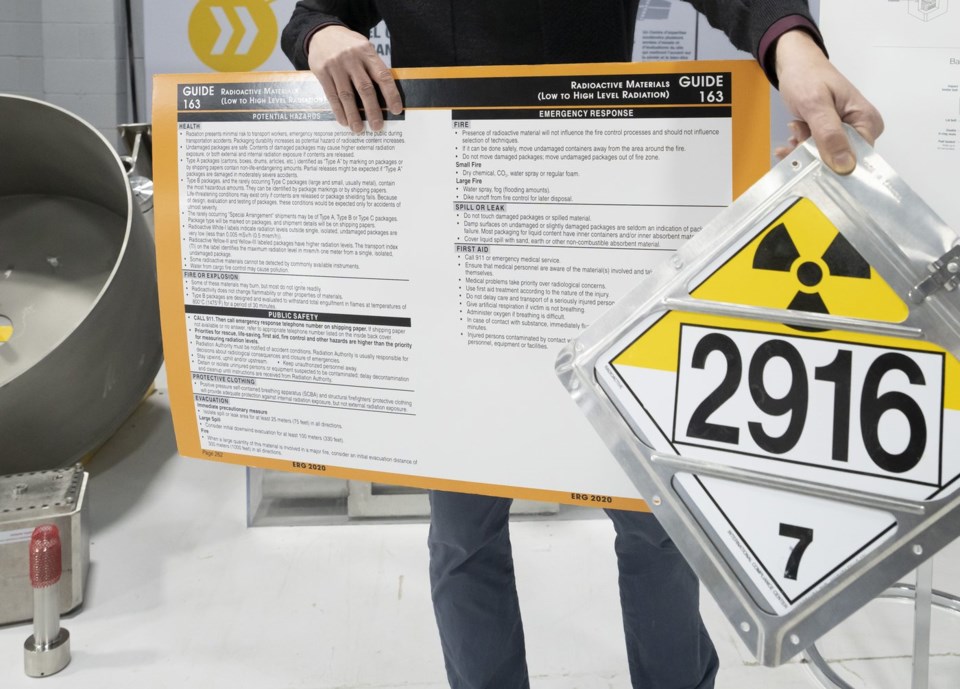TORONTO — An organization tasked with managing Canada's nuclear waste found one site to store millions of bundles of radioactive used fuel for thousands of years hundreds of metres underground — and now it's looking for a second.
As the Nuclear Waste Management Organization begins the regulatory process for a deep geological repository site in northern Ontario to store spent nuclear fuel, after a 14-year site-selection journey, it's also starting to look at the need for another site to hold different types of nuclear waste.
The used fuel from Canada's current fleet of nuclear reactors is ultimately destined for the first deep geological repository, expected to be in operation starting in the 2040s.
But aside from that high-level waste, the NWMO said there needs to be a long-term plan to manage intermediate-level waste and high-level waste that isn't fuel.
That includes used components from nuclear reactors such as filters, resins and pumps, as well as waste from medical isotope production. Currently, the waste is stored in above-ground or in-ground storage silos, but that won't be adequate for the hundreds of years or longer that it will take for the radioactivity to decay to naturally occurring levels, the NWMO said.
The second repository is in the extremely early stages, with the start of a search in earnest for a location potentially years away. The NWMO is taking its time to consult widely in order to first develop a process by which it will eventually determine a site, said Joanne Jacyk, director of site selection for intermediate-level waste.
"We will be starting in 2025 to engage with Canadians and Indigenous people to get input into that final site process," Jacyk said in an interview.
"Following (the consultations), when we have a final siting process, we will be launching that and then that's, I think, a really, really interesting and exciting opportunity."
Currently, all radioactive waste in Canada is safely managed following international standards, the NWMO said, but there is no long-term plan for about 16 per cent of it.
Most of that 16 per cent is deemed low level, such as mop heads and rags from power plants, which requires isolation for less than 300 years and can be disposed of in near-surface facilities, the NWMO said.
Most of the rest is intermediate-level waste and the NWMO has concluded based on guidance from the International Atomic Energy Agency that a second deep geological repository is the most appropriate place for long-term storage.
The organization also considered instead using deep boreholes, a series of narrow shafts about 500 to 1,000 metres deep, but those have far less capacity than a repository, which involves cavernous placement rooms between 650 to 800 metres deep.
The host communities for the first deep geological repository are the Township of Ignace and Wabigoon Lake Ojibway Nation in northern Ontario. They were selected last year in a process that began in 2010.
Some environmental groups have raised concerns with that first deep geological repository and the process used to select it, including that Ignace should not have been able to agree to be a host community as the site is not within Ignace's boundaries.
The NWMO says it is on unincorporated land within the traditional territory of Wabigoon Lake Ojibway Nation, and Ignace is the nearest municipality.
Brennain Lloyd, with the advocacy group Northwatch, said the waste should be stored where it can be closely monitored for its whole radioactive lifespan, and if there are failures in one of the layers of protection those can be addressed, rather than having it relatively inaccessible hundreds of metres underground.
"We do think that it's a good idea to be coming up with some long-term management plans for the intermediate-level waste and for the low-level waste," she said.
"We think it's a good idea to have a management strategy. We just don't think this is the one."
This report by The Canadian Press was first published April 4, 2025.
Allison Jones, The Canadian Press




